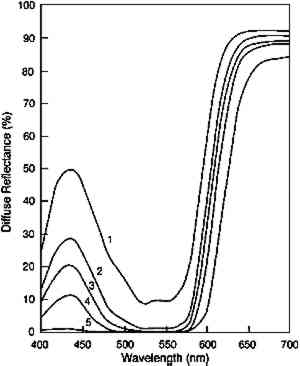FURTHER STUDIES ON TRANSPARENT GLAZE FADING: CHEMICAL AND APPEARANCE KINETICSPAUL M. WHITMORE, & CATHERINE BAILE
2 THE OPTICS AND APPEARANCE OF TRANSPARENT GLAZESWhether their function is to provide passages of high-chroma color, alter the hue of an underlying paint layer, or soften the transition between different colors, transparent glazes perform their function through their ability to selectively absorb, sometimes nearly completely, certain wavelengths of light while transmitting other wavelengths with little optical scattering. Glazes owe their special appearance qualities to the optical properties of the constituent colorants. In general, a “transparent” glaze is formulated with colorants that possess two features: selective absorption of certain wavelengths of visible light and weak scattering of those wavelengths that are not strongly absorbed. These properties allow glazes to be formulated or applied so that their transmittances (or reflectances over reflective substrates) are very low (near zero) at the absorbed wavelengths while remaining high at the wavelengths that are not absorbed strongly (fig. 1). The
TABLE 1. MUNSELL NOTATION FOR GLAZES USED IN THIS STUDY While these are the most essential optical qualities of glazes, the Munsell notations shown in table 1 demonstrate that glazes also can display two other peculiar appearance properties. The hue of a glaze is actually a function of its colorant content; the PR66 glazes illustrate this phenomenon by shifting from a red-violet toward a red as the colorant loading increases. This shift occurs because the colorant absorption bands are usually defined by a reflectance minimum between spectral regions of higher reflectance, where the absorption strength is lower. At high enough colorant content, however, one region of higher reflectance may be reduced to essentially zero reflectance, and by eliminating the reflectance of these wavelengths the apparent hue of the glaze is shifted. For the PR66 glaze, the reduction of reflectance in the 400–500 nm region in the very dark glazes results in the hue shift from the purple of the pale glaze toward the red as the blue reflectance is reduced. This shift in hue of the PR66 glazes can also be seen in the chromaticity diagram of figure 2, which illustrates the shift in dominant wavelength (under CIE Illuminant C, simulating overcast daylight sky) from 506c (purple) to 630 nm (red) with increased colorant loading. (The lowercase “c” following the wavelength number denotes the “complementary” wavelength, following the convention of describing purples by the dominant wavelength of their complementary greens.)
The other notable appearance change in glazes of different colorant concentration is the tendency of very dark glazes to display lower chroma. At very high pigment loadings, the weak absorption and scattering of the pigments slightly lower the reflectance at the nonabsorbed wavelengths. This reduction in the high reflectance spectral regions results in a lowering of the chroma of the glaze, demonstrated in the Munsell notations listed in table 1. Both the hue changes and the chroma changes with pigment loading have been noted by Johnston-Feller and Bailie (1982) and Johnston-Feller (1986). Both of these unusual appearance changes will be demonstrated in the fading of the glazes, in which the concentration of colorant is gradually reduced. However, because the fading does not produce a glaze having only lower pigment concentrations, the faded glazes do not reproduce exactly the appearance of the unfaded glazes at those lower colorant concentrations. |

